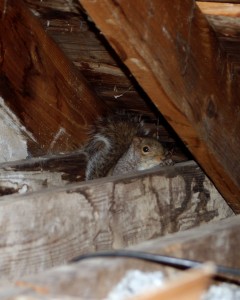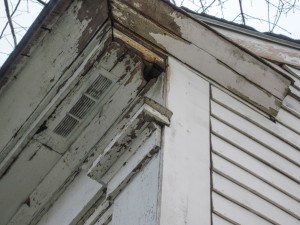“Spring work is going on with joyful enthusiasm.” ― John Muir
In other words, birthing season will soon be upon us. And though it’s fun watching animal families grow up in our backyards, it’s best that they don’t give birth within our buildings. Because female squirrels seek safe places to raise their young in late winter and early spring, now is the time to ensure they stay out of your attic.
Give them an opening and squirrels will happily turn your attic into a nursery. Photo credit: Carosaurus
Your first step? Monitoring is key to sound IPM. In this case you want to inspect your building exterior, especially if you’ve had problems in the past. Since squirrels are climbing animals and there’s no way could you see all possible entry sites from the ground, you’ll need a ladder. If you find a likely entry hole, don’t close it without first determining if it’s active. Trapping an animal (or its nest) inside can provoke it to chew its way back out — or in. Monitor an opening by inserting a soft plug (crumpled newspaper works fine) into the hole. If the plug is still there after two days and you see no other signs of activity inside the building, it should be safe to permanently close the hole. What to close it with? Think galvanized sheet metal or galvanized metal mesh, which resist strong teeth.
Do you need to remove squirrels from the building? Trapping is the most common and successful method. By New York law, however, without a state-issued permit squirrels must be released on the property or humanely destroyed. Another method is to install one-way doors (also known as excluders) over entry holes. These devices allow animals to leave — but not re-enter — the structure. To be successful, one-way doors need to be combined with preventive exclusion (such as metal mesh and caulk) on other vulnerable sites on your building, since exclusion and prevention are also key IPM practices.
Openings such as this one provide access for squirrels, raccoons, mice, rats, birds, stinging insects, bats, snakes, … Photo credit: BillSmith_03303
No rodenticides or other poisons are legally registered for squirrel control. Although a variety of repellents and devices make marketing claims about driving squirrels from buildings, their efficacy is questionable.
To prevent future problems, reduce squirrel access to the building by keeping trees and tree branches at least 10 feet away from the structure and make sure all vents are made of animal-resistant materials.
For information on IPM for nuisance wildlife, refer to Beasts Begone!: A Practitioner’s Guide to IPM in Buildings and Best Practices for Nuisance Wildlife Control Operators.
(Adapted from Controlling Squirrel Problems in Buildings by Lynn Braband, NYS Community IPM Program at Cornell University)

